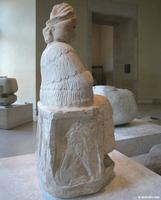

Iran, Susa, 2100 B.C.
Akkado-Elamite
Narundi and Arundhati
Alcor, the small star near zeta Ursae Majoris or Sapta Rshis, is known in India as Arundhati.
There is a correspondance in the Akkado-Susian (Elamite) Narundi, sister of the Sibitti, the "Seven", known as such since Babylonian times.There is a statue in the Louvre Museum of earth goddess Narundi dated from the time of Elamite king Puzur-Inshushinak, near 2100 B.C. Her cult was already known to the Akkadian predecessor.
http://www.insecula.com/us/oeuvre/O0011201.html
http://www.3dsrc.com/antiquiteslouvre/index.php?
We have also the Seven Wise Ones who laid the foundation of Uruk in the Gilgamesh epic in which Enkidu also prophecies to the goddess of wine of eternity, named Siduri Sabitu (seven) who had lured him into the city: "the wife, the mother of seven, shall be forsaken."
Are Narundi, split perhaps as Na-rundi, and A-rundhati also etymologically connected?
regards,
Ishwa
adhin88@yahoo.com
Sculpture:Empire de Puzur-Inshushinak
Material : LimestoneDate : near 2100 B.C.
Artist : Anonyme
Time of : Puzur-Inshushinak
Place : Louvre MuseumIran
Rerelated : Suse (Elam)
Acquisition : Fouilles J. de Morgan (1907)

0 Comments:
Post a Comment
<< Home